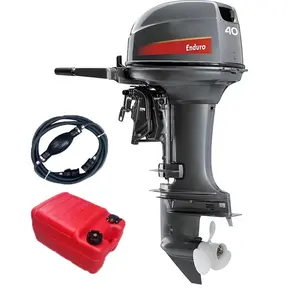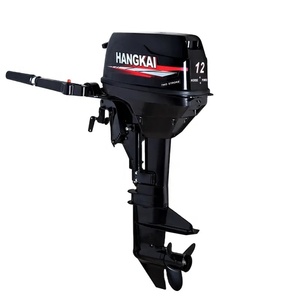(8255 products available)






































































































































































Two-stroke outboard motors, or 2-stroke outboard motors, are engines that combust fuel and air, pushing a piston on each downstroke. These motors are lighter, simpler, and more powerful than four-stroke outboard engines. They produce a higher power-to-weight ratio and are used mainly in smaller fishing boats and inflatable boats. There are several types of brand-new 2-stroke outboard motors which include:
Outboard motors have specifications that are designed for different applications, and these are some of the things buyers need to know before purchase.
With the right care and maintenance, 2-stroke outboard motors can last for many years. Here are some of the maintenance tips:
Choosing the right 2-stroke outboard engine is a difficult task for buyers. They should consider the following factors to get suitable motors for their needs.
Purpose
What is the purpose of the motor? Users should consider the type of boat and its usage before purchasing. For example, if the boat is used for fishing, a motor that is quiet and fuel efficient is needed. Whereas, if the boat is used for water sports, a motor that provides high speed and performance is required.
Power and weight
Buyers need to match the motor power with their boat's capabilities and requirements. They should consider the weight of the motor as well. A heavy motor will make the boat slower and harder to handle.
Fuel efficiency and emissions
Buyers should consider motors that have good fuel efficiency to save money and reduce emissions. A motor that produces low emissions is also good for the environment.
Reliability and maintenance
Buyers should choose motors from reputed brands with a reliable and long-lasting motor. They should also consider the ease of maintenance and availability of spare parts.
Noise and vibration
Users should consider the noise and vibration levels of the motor. A motor that is quiet and has less vibration will provide a more comfortable experience.
Weather and water conditions
Buyers should consider the weather and water conditions where the motor will be used. They should choose a motor that is suitable for different weather and water conditions.
Budget
At last, buyers should consider the cost of the motor. They need to get a motor that has good quality and fits their budget.
Mounting a 2-stroke outboard motor to a boat is a pretty straightforward DIY process that can be carried out with a few basic tools. Here are the steps:
1. Choose the right location: Find a suitable spot on the transom (the back part) of the boat that is strong enough to hold the motor and is clear of any obstructions in the water.
2. Prepare the mounting area: Clean the mounting area and ensure the motor will fit without any issues.
3. Align the motor: Position the motor on the transom and align it with the mounting holes. Make sure it is straight and at the correct height.
4. Mark the holes: Use a marker to mark the mounting holes on the transom.
5. Drill the holes: Remove the motor and drill holes in the transom where the marks were made. Make sure the holes are the right size for the mounting bolts.
6. Apply sealant: Put marine sealant around the holes to prevent water from leaking through the transom.
7. Mount the motor: Align the mounting holes on the motor with the holes on the transom and insert the bolts. Tighten the nuts securely, ensuring the motor is firmly attached to the boat.
8. Connect the steering: Depending on the motor and boat design, connect the steering system between the motor and the boat.
9. Connect the fuel system: Follow the manufacturer's instructions to connect the fuel system, ensuring there are no leaks.
10. Connect the electrical system: If the motor has electric start or other electrical components, follow the manufacturer's instructions to connect the motor to the boat's electrical system.
11. Check everything: Double-check all connections, ensure the motor is properly mounted, and perform any necessary adjustments.
Once the motor is mounted, doing routine maintenance and repairs is pretty straightforward. Users can refer to the user manual for detailed instructions on maintaining and repairing specific outboard motors.
Q1: Are 2-stroke outboard motors more fuel-efficient?
A1: Traditionally, two-stroke outboard engines used more fuel compared to their four-stroke counterparts. Nonetheless, advancements in technology have significantly improved the fuel efficiency of many modern two-stroke engines.
Q2: Can I convert a 2-stroke outboard motor to run on electric power?
A2: While it's technically possible to convert a 2-stroke outboard engine to run on electric power, it is often more practical and cost-effective to replace the existing engine with an electric outboard motor. Many manufacturers offer electric outboard solutions that are designed for various boat sizes and types.
Q3: Are 2-stroke outboard motors suitable for large boats?
A3: Yes, brand new 2-stroke outboard engines are suitable for large boats. However, for larger vessels, more significant and more powerful engines may be required to ensure adequate performance and efficiency. It's essential to consult the manufacturer's recommendations regarding engine size and type for specific boat models.
Q4: Can 2-stroke outboard motors run on high-octane gasoline?
A4: Generally, brand new 2-stroke outboard motors do not require high-octane gasoline. Most manufacturers recommend using regular unleaded gasoline with an octane rating of 87 or higher. Using high-octane gasoline is unlikely to provide any significant benefits in terms of engine performance or efficiency.